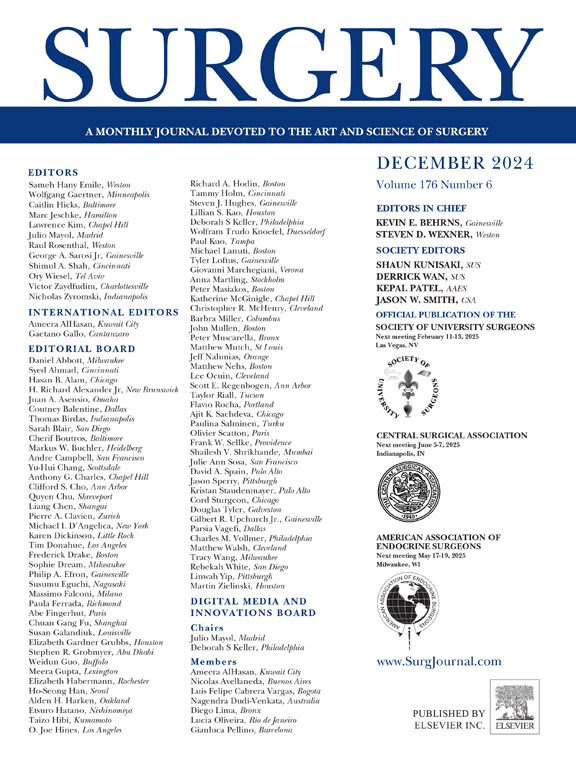Utility of 4-dimensional computed tomography in predicting single-gland parathyroid disease—Can we abandon intraoperative parathyroid monitoring?
IF 3.2
2区 医学
Q1 SURGERY
引用次数: 0
Abstract
Background
Four-dimensional computed tomography is routinely used to localize parathyroid disease, with consistently excellent parathyroid gland localization rates reported. This study evaluated whether pairing 4-dimensional computed tomography results with preoperative clinical variables can accurately predict single-gland disease in primary hyperparathyroidism.
Methods
Patients with primary hyperparathyroidism who underwent both 4-dimensional computed tomography imaging and parathyroidectomy between January 2019 and September 2021 at a large academic health system were included. Patient demographics, preoperative characteristics, and peri- and postoperative data were collected. The accuracy of 4-dimensional computed tomography in correctly identifying patients with single-gland disease with and without preoperative calcium and parathyroid hormone levels was calculated. Single-gland disease was defined by intraoperative parathyroid hormone decrease >50% and a hypercellular gland on pathology.
Results
One hundred seventy-five patients had 4-dimensional computed tomography results suggestive of single gland disease. One hundred fifty-two patients (87%) were predicted correctly to have single-gland disease. The predictive accuracy increased when stratifying by preoperative calcium (≥10.5 mg/dL, ≥11 mg/dL, and ≥12 mg/dL) and parathyroid hormone levels (≥65 pg/mL, ≥100 pg/mL, and ≥200 pg/dL). The accuracy further increased when stratifying by age (≤50 years). Accuracy for single gland disease was 100% when combined with any of the following: (1) calcium ≥12 mg/dL, (2) parathyroid hormone ≥200 pg/dL, or (3) calcium ≥11 mg/dL in patients ≤50 years.
Conclusion
Four-dimensional computed tomography alone accurately predicted single gland disease in 87% of patients with primary hyperparathyroidism. When combined with preoperative calcium, parathyroid hormone and age thresholds, predictive accuracy for single-gland disease approached 100%. Given the high likelihood of single-gland disease in these scenarios, clinicians may consider offering focused unilateral parathyroidectomy without intraoperative parathyroid hormone monitoring in selected patients.
求助全文
约1分钟内获得全文
求助全文
来源期刊

Surgery
医学-外科
CiteScore
5.40
自引率
5.30%
发文量
687
审稿时长
64 days
期刊介绍:
For 66 years, Surgery has published practical, authoritative information about procedures, clinical advances, and major trends shaping general surgery. Each issue features original scientific contributions and clinical reports. Peer-reviewed articles cover topics in oncology, trauma, gastrointestinal, vascular, and transplantation surgery. The journal also publishes papers from the meetings of its sponsoring societies, the Society of University Surgeons, the Central Surgical Association, and the American Association of Endocrine Surgeons.
 求助内容:
求助内容: 应助结果提醒方式:
应助结果提醒方式:


